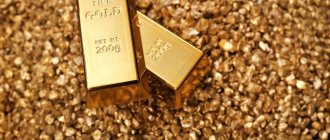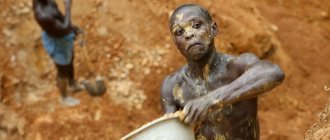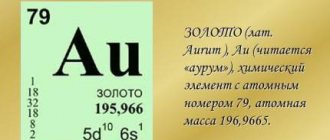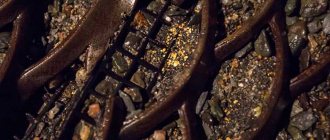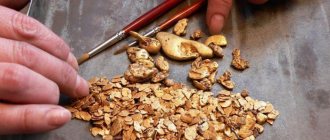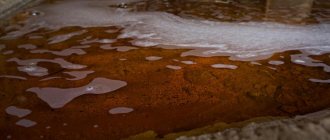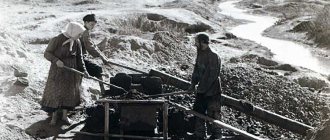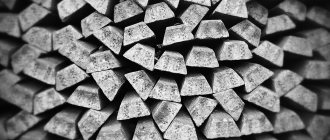How to make a gateway for gold mining with your own hands
This article was born in connection with the increased interest in gold mining. I often get asked questions about how to get gold from streams and rivers? How to make a gateway for gold mining with your own hands? Where and what kind of gateway should I buy? How to make a passage with your own hands?
In this article I will tell you how to make a gateway with your own hands. The equipment is so simple that anyone can make it in a couple of hours at home and in many respects it will be better than a purchased American aluminum gateway, the cost of which in Russia reaches 17,000 rubles.
I’ll tell you how to properly make a gold-catching sluice, a mini device for gold mining, popularly called a prodnushka. This is what the prospectors of Siberia and the Urals call it, the name that came to us from our grandfathers and great-grandfathers is prodnushka.
A passage (sluice) is a box made of three boards, at the bottom of which a mat is laid and a stencil (riffle) is placed. A walk-through made of wood is not only simpler and cheaper than one made of aluminum, but most importantly, if something happens, you won’t mind throwing it away. If you use dry and not thick wood, then the weight will be no more than that of an aluminum analogue, and with a skillful approach, even less. In addition, wooden boards in your car or backpack will not raise questions from strangers; no one will ask what kind of boards they are or ask unnecessary questions. You never know what purpose you need these boards for in the forest.
To make a passage (sluice) for gold mining, the main thing is to follow the basic simple rules in its manufacture, and you will be a more successful gold miner than other prospectors with short purchased sluices.
The longer the hole, the more gold you will catch. Foreign aluminum sluices have a maximum length of 1.5 meters; this is not enough to catch fine gold and disintegrate poorly washed sands or loams. The length of foreign locks is 1.5 meters due to legislation that limits the length of the lock, so that amateur tourists do not wash out all the gold on the stream and leave it to others. For example, in America, Australia, and New Zealand, gold mining is a hobby, like picking mushrooms or fishing in our country.
The width of the sluice depends on the amount of rock supplied; for bucket feeding, a width of 20-25 cm is sufficient.
To make a long and easy-to-carry passage, use a cascade of gateways, for example, install two gateways of 1.5 meters in series, for a total of 3 meters. This is sufficient to trap fine gold and disintegrate the rock.
If the soil is clayey and does not have time to be washed through the passage, you need to use other equipment called butara. I will talk about it in the following articles or videos on my channel www.youtube.com/user/RudolfKavchik
Installation of riffles or as they are also called stencils.
The stencil is the most important part of the pass-through. Behind them, a turbulence of the water flow and its rarefaction occurs. This creates conditions for the accumulation of the heavy fraction behind the riffle plates and the demolition of light unnecessary material. The angle of inclination of the riffle plates depends on the amount of water supplied to the passage and can be from 45 to 78 degrees. The greater the depth of the flow and the speed of the flow of water supplied to the sluice, the greater the angle of inclination of the riffles. The distance between the riffles is 5-7 cm. The shape of the riffles can be straight or with slightly curved edges in the direction of flow.
If the water flow is weak, then riffles are not used. The rock is sifted through a sieve before being fed to the mini device. See the chapter on material screening below.
The next chapter is about a gold catching mat and what to make a gold catching mat from. How to install a passage, sieve and screen for gold-bearing rock. From the history of gold mining - is there a need for a mat on the sluice?
Full set of mini dredges for gold mining
- The complete installation kit includes: Mini dredge for the extraction of placer gold and platinum group metals, assembled:
- — Sluice — Hopper — Support legs — Irrigation system — Rifle — Dredge carpet with a straight cell — Dredge carpet with an inclined cell — Prospector’s moss
- — Motor pump — High-pressure hoses — Polyurethane suction hose (frost-resistant) — Elastic slurry pipe for ejector — 2.3 or 4-inch ejector (to choose from)
For a long time, gold has been assigned the role of world money. The metal has become the basis by which the value of the currencies of different countries is determined and compared. It is not surprising that in such a situation, gold mining has always received increased attention. Thousands of adventurers went in search of the mythical country of Eldorado, where gold bars lie under their feet like simple cobblestones. Today there is no trace left of the former romance. The search for precious metal has turned into a well-functioning technological chain, one of the elements of which is a mini-dredge for gold mining.
Video: How gold is mined
Today, gold mining is not like a gambling adventure that involves some people in ruin and others in riches. Now it has become an active type of income. Enterprises engaged in this type of activity maintain accounting records, calculate costs, and conduct geological exploration using modern technical means and equipment. In general, this is the work of many people of different professions.
The Russian gold industry consists of approximately 400 objects. Most of them are provided with reserves for the next 2-3 years in the long term. But non-industrial mini-placers are guaranteed to provide work for decades.
The process of developing deposits for gold mining includes the following preparatory stages:
Preliminary reconnaissance followed by a clear definition of boundaries; . metallurgy quality analysis and calculations; . formation of the deposit and delivery to industry; . acquisition or lease of land with gold mines; . construction of the mine in compliance with modern technologies.
Gold placers in our time are either deep, or the area of land has dried up significantly compared to the last century. About a century ago, the deposits provided 90% of the world's gold. Now it is approximately 5%.
The names of gold ore mining countries account for about 70 positions. Their leaders include South Africa, Australia, Canada, the USA and Russia. Recently, the Russian Federation has been rapidly increasing its rating and is among the top five leading countries in the production of this precious metal.
Gold mining: equipment
Industrial gold mining is carried out using dredges. This is a bulky unit weighing several tons and the size of a four-story building. The device is equipped with a mechanism with scoops that lifts soil from the bottom of the reservoir. Next, it goes through several stages of washing, as a result of which the metal is separated from the soil and deposited at the bottom of the trays. The advantage of using a dredge is that all stages of gold mining are concentrated on it. A relative disadvantage is that the unit cannot operate without water.
There are two types of industrial dredges:
In both cases, due to the cost, only large mining companies with a state-owned scale of activity will be able to afford to purchase such equipment. For small cooperatives and individual entrepreneurs, mini dredges are more suitable, the prices of which are several orders of magnitude lower.
Non-commercial production
Artisanal gold mining is carried out by prospectors in places where industrial mining was previously carried out, as well as in places where its accumulation is insignificant and it is not economically profitable to build factories and processing plants.
In Africa, South America, and Asia, tens of millions of people are involved in artisanal fishing. Prospectors use manual mining technology, using a tray, which was invented several centuries ago, since the development of this fishery, and, oddly enough, is still relevant today.
The fact is that on an industrial scale, gold mining is carried out only in large deposits and mainly of the indigenous type, and for placer deposits they use dredges and private miners. In some places there is no point in using expensive equipment, and mining companies use individual miners using manual sand washing in a tray.
In Russia, independent fishing is prohibited by law; its implementation requires a license, which is almost impossible for an individual entrepreneur to obtain. Therefore, they get out of the situation by concluding labor contracts with large enterprises that have this permit for mining activities.
The manual technology of gold mining using a tray is quite simple. In the area of the proposed placer on the banks of rivers, prospectors scoop up bottom sand and wash it under the running water of the river. Gold, even the smallest size, settles at the bottom of the so-called mining moss - a vinyl corrugated coating that traps gold particles, and waste rock and sand are washed away.
If gold ore has large accumulations of tiny particles, you can use chemical purification methods - amalgamation, cyanidation, leaching, but these are quite expensive methods; due to the high cost of the reagents and the low concentration of gold in the rock, they are not used by individual miners.
Mini dredge for gold mining: design and principle of operation
A mini dredge is an analogue of an industrial unit reduced in weight and dimensions. If a team of at least ten people is needed to service an industrial dredge, then the minimized option can be easily handled alone. And it’s much easier to buy a mini dredge. At the initial stage, some material investments will be required, but with an average device productivity of 100 to 1000 kilograms of soil per hour, the costs will pay off quite quickly.
Mini dredges for gold washing consist of the following elements:
The equipment carries out gold mining in the following way: water is pumped into the ejector chamber under high pressure; then it is thrown out with sand and earth into the washing hopper; Then the pump turns on and the water washes out unnecessary slag through the airlock, leaving gold nuggets on the carpets.
Hydraulic gold mining method
The extraction of yellow metal in sea areas, river deltas, and swampy areas does not allow the use of machines and special equipment. In its place comes the dredge - a complex floating or stationary installation that is capable of removing soil from great depths - from 5 to 50 meters.
The dredge is a mechanized unit equipped with buckets that operate on the principle of a chain excavator. The main mechanism is installed on a floating platform, its dimensions depend on the size of the bucket - small, capable of extracting up to 100 liters and large - up to 250 liters at a time.
The dredge can be the size of a four-story apartment building and weigh up to 1,400 tons. On board the floating installation there is all the necessary equipment for washing sand or bottom rock; up to ten people can operate the largest dredge, and only one can operate the small one.
Dredging can provide high productivity, which previously would have required 12 thousand miners. Depending on the place of application, the dredge can be sea or continental. Offshore installations are based on keel vessels that can move either independently or under tow. Continental ones are built on the basis of a flat-bottomed vessel. In order for the dredge to work effectively, a sufficient amount of water is necessary, so during the period of shallowing of rivers it is impossible to use it.
Dredge for gold mining
Individual prospectors make homemade mini-dredges, they weigh up to 90 kg. For it they use:
- floating installation - some semblance of a boat or catamaran;
- engine;
- centrifugal pump;
- trench for washing sand;
- injector.
Using a pump, water enters the injector and is filtered; pebbles, sand, and gold-bearing rock settle on the washing grid, and the miner independently separates the yellow metal from impurities.
How to buy a mini dredge?
Mini dredging is an effective way to mine gold, which determines its continued demand among miners.
You can buy a fully equipped mini dredge at an affordable price from.
A mini dredge for gold mining, the price of which will be a maximum of 75 to 140 thousand rubles, depending on the model’s configuration, but by speeding up the gold mining process, it alone can replace several dozen people with manual trays and significantly reduce labor costs.
You can make a mini dredge yourself, but in this case you will need certain knowledge about the extraction of placer gold, and you will also need to make certain components. Therefore, it is better to entrust the production of equipment to professionals who know their business in this area! For example, the question will arise where to buy a lower ejector and an upper ejector for a mini dredge. The answer is simple - you can buy components and equipment for mini dredges at. It should be taken into account that the mini dredge will require increased attention and permanent improvement, and installation will take about one month. If you want a mini dredge for gold mining to be highly enriched and to last a long time without losing its functionality, it is better to purchase ready-made equipment with a number of additional advantages.
How to make a sluice for gold washing with your own hands. Part 1.
Installation of riffles or as they are also called stencils.
The stencil is the most important part of the pass-through. Behind them, a turbulence of the water flow and its rarefaction occurs. This creates conditions for the accumulation of the heavy fraction behind the riffle plates and the demolition of light unnecessary material. The angle of inclination of the riffle plates depends on the amount of water supplied to the passage and can be from 45 to 78 degrees. The greater the depth of the flow and the speed of the flow of water supplied to the sluice, the greater the angle of inclination of the riffles. The distance between the riffles is 5-7 cm. The shape of the riffles can be straight or with slightly curved edges in the direction of flow.
If the water flow is weak, then riffles are not used. The rock is sifted through a sieve before being fed to the mini device. See the chapter on material screening below.
Gold catching mat.
A gold catching mat can be made from any natural fabric, such as burlap, tarpaulin, and even an ordinary waffle towel that housewives use in the kitchen will do. The main purpose of the mat is to ensure that the riffles adhere to the bottom of the sluice so that the accumulated material is not washed away by the leaking flow under the riffles.
Industrial enterprises use cellular gold-collecting mats. This is due to the technological process of gold mining. The rock is transported to the industrial equipment by multi-ton Belaz trucks, washing thousands of cubic meters of gold-bearing rock per day. Each Belaz truck contains ten grams of gold, which is brought in for washing every few minutes. It is not profitable for the enterprise to stop the washing process to unload the industrial equipment; this will require stopping production for 2-3 hours, and time is gold, in the literal sense of the word. The industrial device is unloaded once a day. Due to the large amount of washed rock, there was a need for cellular mats with a high profile, which accumulate heavy metal and prevent it from being carried away by the flow of water, which increases the time of effective operation of the industrial device.
At its core, a honeycomb mat works like a stencil/reel. In the depths of the cells, vortex flows are created that carry away light particles of sand, leaving heavy metals at the bottom: gold, platinum. You don’t have to use a cellular mat in the passageway, since the rock for washing is not supplied by dump trucks, and gold can be easily removed at any time as heavy material accumulates. In addition, a cellular mining mat is not easy to obtain and its cost of several thousand rubles is not at all justified when used on mini devices.
You can make an analogue of a cellular mat yourself from an ordinary household cellular mat, which many people have on their porch and is sold in every hardware store under the name “anti-slip coating.” The mesh size of the anti-slip coating is approximately 5 mm. See photo.
The anti-slip coating is laid on top of the rag mat. Ribbons are installed on top. Such a system will work no worse than an industrial rug, it’s easier to buy, and its cost is much lower, and if something happens, you won’t mind throwing it away.
To be continued... https://vk.com/rudolfkavchik?w=wall24596209_3003
Author Rudolf Kavchik, Irkutsk
Photo by Rudolf Kavczyk
How to make a gateway for gold mining with your own hands. To avoid buying.
Video on how to use the pass-through. Also, you will learn what raft, peat and gold-bearing rock are - sand or layer.
Film directed by Rudolf Kavczyk
Methods of gold mining in Russia
Gold is considered an expensive, but still not a rare metal. Methods for its extraction from the soil are conventionally divided into mechanical and chemical (when combined with other elements). If we talk about the Russian Federation, the following are recognized as the main ones.
- Amalgamation is based on the special property of mercury to dissolve elements in itself. The rock containing gold is placed in a container with Hg. Over time, these metals combine to form an amalgam, from which the mercury is subsequently evaporated.
- Crystallization using NaCN - this method is very similar to the previous one, only instead of poisonous mercury, the gold-bearing rock is mixed with sodium cyanide, which, when combined with gold, forms yellow crystals.
- The dredge method is the use of a special floating installation (dredge), which collects enriched rock and washes out the precious metal from it.
These are the main methods of industrial gold mining in Russia. In addition to them, manual washing using a sieve is also widespread.
Industrial mining
The main methods of gold mining on an industrial scale come down to extracting gold-containing ore to the surface. Depending on the depth of occurrence, this is carried out either by quarry, open-pit method, or by means of mines, they are called mines.
First, the upper layers of waste rock are removed, then, having reached the gold-bearing rock, it is loaded onto a special transport, which is delivered to the processing plants. In order to extract ore, it can be blasted or mined using equator buckets. At processing plants, the resulting pieces of ore rock are crushed into smaller ones and subjected to various processing methods:
- melting;
- electrolytic;
- extraction method;
- amalgamation method.
The process of gold mining in the Urals in detail
After crushing the rock, granular lead, alkaline sodium or potassium are added to it. This mixture is sent to the oven after keeping it to a certain temperature, then the process of leaching with water occurs. As a result of this, the waste rock and impurities are split and washed off with water, and the gold precipitates, but not completely pure, it still contains slags, which are removed with hydrochloric acid.
The electrolytic method of processing gold ore makes it possible to obtain a product of high purity. This method requires a cathode - pure gold in the form of a plate and an anode - hydrochloric acid (it includes chemical elements - Cu, Ag, Fe, Pd, Pt). Next, the electrolysis process is carried out, as a result of which the pure gold included in the anode is concentrated on a gold plate. The disadvantage of this method is the high energy intensity of the process, as well as the need for frequent electrolyte changes.
Method for extracting gold from brown and hard coals
Extraction is the most common method of beneficiation of gold ore. It is based on the use of various liquids that can break down the rock structure and release gold. The most commonly used are diethyl ether and hydrochloric acid solution.
After washing the ore (usually three cycles are enough), gold must be restored from the organic state of the substance to the metallic phase; this is done by keeping it in a hot solution of oxalic acid; the process lasts up to three hours. After all the procedures, gold is obtained with a high purity of 99.99%.
Until recently, the amalgamation method was the only available method for purifying ore from impurities and isolating gold from it, based on the use of mercury. It is able to attract gold particles, and when washed, the compounds settle to the bottom of the container. This method is quite simple and gives good results, but due to the high toxicity of mercury it is prohibited in Russia and a number of other countries.
What is a dredge?
Dredges are special machines designed to work with different types of soil. The main functioning element of such installations can be either a multi-bucket in-line mechanism or a suction hose (if the rock is loose). The scooping mechanism is adjusted by a staff of 10 people.
Simply put, this unit acts as an attachment that can be installed on a floating platform or ground transport, and is somewhat reminiscent of a conveyor. Only instead of a tape, movable scooping devices are attached to the frame. They are the ones who scoop out gold-bearing ore from a quarry or from the bottom of seas, oceans, rivers, etc. Subsequently, the extracted conglomerate containing the required element is transported for processing. Below is a photo of the car itself.
Dredge device
If we talk about a dredge with a bucket working element, then there is nothing complicated in its design. However, there is also a vacuum type of installation, the design of which is different in many respects. It is intended for bulk deposits, which include marine gold-bearing sands. The machine consists of the following mechanisms.
- Pump - creates a suction effect.
- Sleeve - passes rock through itself under the influence of a created vacuum.
- Auxiliary hose - connected to a pump that pumps water, and directs it through a high-pressure pipeline into the hose.
- A sluice is a kind of container that calibrates the rock and throws away large debris.
- Butara - acts as a flushing mechanism.
All these elements work harmoniously, that is, together. Most often they are installed on a floating gold mining platform that operates on water. They are rarely used in quarries.
Operating principle of the dredge
Dredge equipment, regardless of whether it is a pump or a bucket, is designed for one purpose - the extraction of ore containing valuable minerals and its transportation to the destination, that is, to the place where the mined material is either processed or immediately washed (as in the case with gold).
For example, a bucket dredge most often simply dumps the mined conglomerate into a heap, but a floating pumping station immediately washes and collects pure gold, throwing unnecessary debris to the bottom. But the principle is the same - extract, transport and sift.
Classification
The global specification distinguishes two main types of machines.
- 1st class (quarry dredges) - work in artificially created reservoirs on floating platforms.
- Class 2 (water dredges) - designed for the extraction of bulk rocks from the bottom of seas, lakes, etc.
In addition, dredge installations can be divided depending on their design features and capabilities.
- By type of energy used.
- According to the method of movement.
- Depth of extraction.
- Depending on the type of bucket.
- According to the size of the scoop.
- Method of operation of the bucket chain.
There are quite a few different classifications of installations, but the main one is considered to be the world one, that is, 1st and 2nd classes.
Mini dredge
Another variety is a compact unit that resembles a full-fledged pumping dredge platform. At its core, this is the same installation, only in a smaller version and, accordingly, with limited productivity. It is used mainly by hired miners engaged in legal gold mining.
Features of gold mining using dredges
Industrial gold mining is carried out in several ways. One of them is hydraulic. In this process, gold is separated from the rock under high water pressure. But today the second method using a special machine is more effective.
The dredge used to extract gold is a modern gigantic unit, approximately the size of a four-story building and weighing up to 1,400 tons. Its role is difficult to underestimate - this floating structure is equipped with a set of scoops for lifting rock from the bottom. After washing it, the desired gold ore is deposited.
The equipment installed on the unit makes it possible to carry out all activities related to the development of placer deposits - from mining and delivery to extraction and disposal of waste. The electric dredge is controlled with the participation of 9 people. Previously, such productivity could be achieved by 12,000 gold miners using homemade trays.
Today, dredges that develop heavily watered deposits of valuable minerals are divided into two classes - continental and marine. Both are designed according to the same principle: a floating vessel, masts, a device for scooping and maneuvering, processing equipment, etc. The difference is that sea stalkers and piles are absent.
The continental dredger is used for the development of placers on continents, often adjacent to river reservoirs. Its installation is carried out on a pontoon.
Marine - in addition to gold, it successfully mines diamonds and various types of minerals. In particular, deposits containing titanium and zirconium are located in deep sea and large-lake waters. The installation of the structure-unit takes place on keel-mounted self-propelled or towed vessels.
Theoretical descriptions of the dredge structure are incomparable with the video, which reveals the powerful capabilities of the gold mining unit in full screen and on a large scale.
How to check the flushing unit?
Before mining gold, the equipment should be thoroughly checked. The bottom line is to test the gateway for performance, namely, the capture of small particles of gold from the ore. To do this, take some dense metal, for example, lead, and paint it in a bright color. After this, it is poured into a portion of soil and washed.
Thus, the dredge will catch brightly colored metal no worse than gold. If only 2-3 pieces are lost in the process, then the unit can be considered quite serviceable, and in practice it will perform well.
Is it possible to make a dredge with your own hands?
Based on what was written above, it is theoretically possible to make a mini dredge, but you will have to buy some additional parts. In any case, it will be much cheaper than purchasing a new device (about 3 times). However, it is not a fact that a device assembled by yourself will work well. When designing, you need to take into account many nuances.
Required tools, materials and components
Self-production only involves assembling all the mechanisms into one whole, since it is almost impossible to construct them with your own hands. The list of what you will have to buy consists of the following units.
- Motor - it will turn the main elements.
- Pump - a centrifugal water pump is suitable.
- Compressor - needed to produce air for breathing underwater.
- Pipes are a readily available material.
I would like to draw your attention to the fact that the pump and compressor must be attached to the motor and use its energy to function. Therefore, when purchasing, you need to ensure that their installation is as simple as possible.
You can also buy a gateway, but it’s quite possible to make it yourself. To do this, you will need aluminum profiles, galvanization and metal of various shapes.
General form
Conventionally, mini dredges are divided into portable and stationary (more productive). The latter are considered more cost-effective because they can operate in deeper bodies of water and are equipped with a compressor to generate air so that the miner can remain under water for a long time. General diagrams and drawings of such installations are presented below.
In addition to these, there are also so-called hand dredges, which are convenient to work with in shallow water or in streams. The principle of operation is the same, only all the equipment is attached very compactly, which allows you to carry it in your hands. The unit itself is somewhat reminiscent of a vacuum cleaner for gold.
Work progress
So, you need to start building a dredge for gold mining with a frame for which metal profiles are suitable. It can be of any shape, but it is advisable to make it so that it is easy to install attachments later.
After collection, floating elements (tanks, barrels, hollow pipes) are installed on the created base, which will allow the entire installation to move freely on the surface of the water.
When the main part is ready, you can attach the motor to the frame, and then the pump and compressor to it. Then, accordingly, install pipes - one for collecting water, the second for supplying it under pressure, the third, the most massive, for collecting ore, sand, etc.
The last thing to install is a gateway, which is connected to the main hose, after which the homemade mini dredge is checked. To better understand exactly how it works, you can watch the video.
How to pan or mine gold yourself using a mini dredge?
Before engaging in such a business, you need to know that the mining of precious metals is considered illegal and is punishable in accordance with current legislation. However, this does not stop gold miners, which results in the widespread spread of this fishery in the eastern part of Russia.
You can work with such a device both on land and in reservoirs, but in both cases a water supply is required. In the first, the ore will enter the gateway under the influence of injection, and in the second, it will be done manually, that is, you will have to work with a shovel. There is no particular difference between these methods, and they are both applicable.
DIY gold trap lazy person. Types of equipment for gold mining
Vyacheslav Bogdanovich
In known gold deposits, in quartz veins, the distribution of gold is linearly discrete. Approximately half of the low-grade reserves are confined to linear structures, the other half to local gold columns with hurricane grades within these linear structures. As a rule, a gold quartz vein object without known gold pillars will receive a negative assessment in the early stages of exploration. Geologists, as they are taught, divide the study of an object into stages - prospecting, prospecting and evaluation, preliminary exploration, detailed exploration. At each stage, its own object of study is outlined - a potential gold ore field, ore-controlling structures, ore-bearing structures, individual ore bodies. And only at the last stage (maybe), if they get around to it, they start looking for gold ore pillars. Methodologically, this is all correct, but the result of such searches is usually zero. Miners and prospectors all over the world do everything the other way around - first they go to gold ore pillars (nugget nests), and then they begin to figure it out - what did they find? In general, finding quartz veins is relatively simple compared to other types of gold mineralization. Quartz responds very poorly to weathering processes. Quartz veins in the form of bedrock outcrops can be observed in the bed or sides of streams, on slopes, and watersheds. Even if the quartz vein is located under the soil-vegetative layer, it is located at a shallow depth, half a meter or at the depth of a shovel bayonet, while the bedrock host rocks can be opened in a ditch at a depth of 2-3 meters. At the first stage of studying a promising area, determining the strike of the ore-bearing structures is of great importance. Any textbook on prospecting says that when searching for gold, profiles should be located across the strike of ore zones. This is something of an axiom. This often happens: profiles go in one direction, and ditches and well lines are located at an angle to them, or even perpendicular. This means that at the design stage, geologists made a mistake in determining the extent of the gold zones. Sometimes it turns out that the apparent strike of gold mineralization is associated with ore-controlling structures, and the ore-bearing zones go in a completely different direction. The question is how to determine the extent of gold ore zones in a specific prospecting area at the initial stage, when the ore bodies themselves are not yet available? One of the methods for determining the strike of ore-bearing structures is the linear productivity of mined gold placers (if such information is available). To a first approximation, the river network reflects the strike of the main structures. When the gold placer coincides with the strike of gold ore bodies, the maximum uniform contents and the highest linear gold productivity are observed. If empty intervals and very rich areas are observed within the placer, the ore zones are intersecting with respect to the placers. Also very important for determining the strike and searching for primary sources is information about the size of gold along the entire length of the mined placer. Large gold and nuggets are practically not transported from the root source, and if they can be traced over a long distance, it means that the stream valley runs along the strike of the gold ore bodies. This can be clarified using a specific example - the western part of the Dambukinsky gold-bearing region. Most geologists believe that "the predominant strike of the main ore-bearing faults is northwest," consistent with the strike of the main structures and gold mineralization. When deep drilling was carried out in one of the prospecting areas, 20 holes of 100 m each, the ore bodies turned out to be confined to the northeastern structures. The maximum linear productivity of gold placers and nuggets is also confined to areas of northeastern-trending valleys. Gold mineralization of the Dambukinsky region manifested itself during two mineragenic stages - Early Proterozoic and Mesozoic (Cretaceous stage). The Early Proterozoic mineragenic stage is characterized by relatively fine high-grade gold, associated with northwestern structures and intrusions of basic rocks. The Mesozoic era of tectono-magmatic activation is manifested mainly in the northeastern structures, associated with small bodies of granitoids with disseminated sulfides. It is characterized by low-grade light yellow gold and the presence of a large number of nuggets. In most cases, the Early Proterozoic and Mesozoic mineragenic eras occur together in the same areas, with different strikes of ore-bearing structures. Gold pillars are confined to areas of the maximum number of stages of mineral formation, that is, northwestern and northeastern structures. The intersections of these structures are structural traps for gold pillars and should be assessed at the earliest stages of exploration. In the Dambukinsky ore district, a zone of oxidation of gold ore pillars was mined (Zolotaya Gora, Uspenovskoye, etc.). This is a typical zone of secondary gold enrichment, which should be assessed separately from primary ores. Sulfides in the oxidation zone are completely decomposed. Oxidation products in the form of ocher powder with rich gold and nuggets accumulated in the cavities, forming lenses and pockets. The gold content in oxidized ores increases hundreds of times compared to primary ores. There are examples when the contents in ditches were 100-200 g/t, and in deep wells 1-2 g/t.

